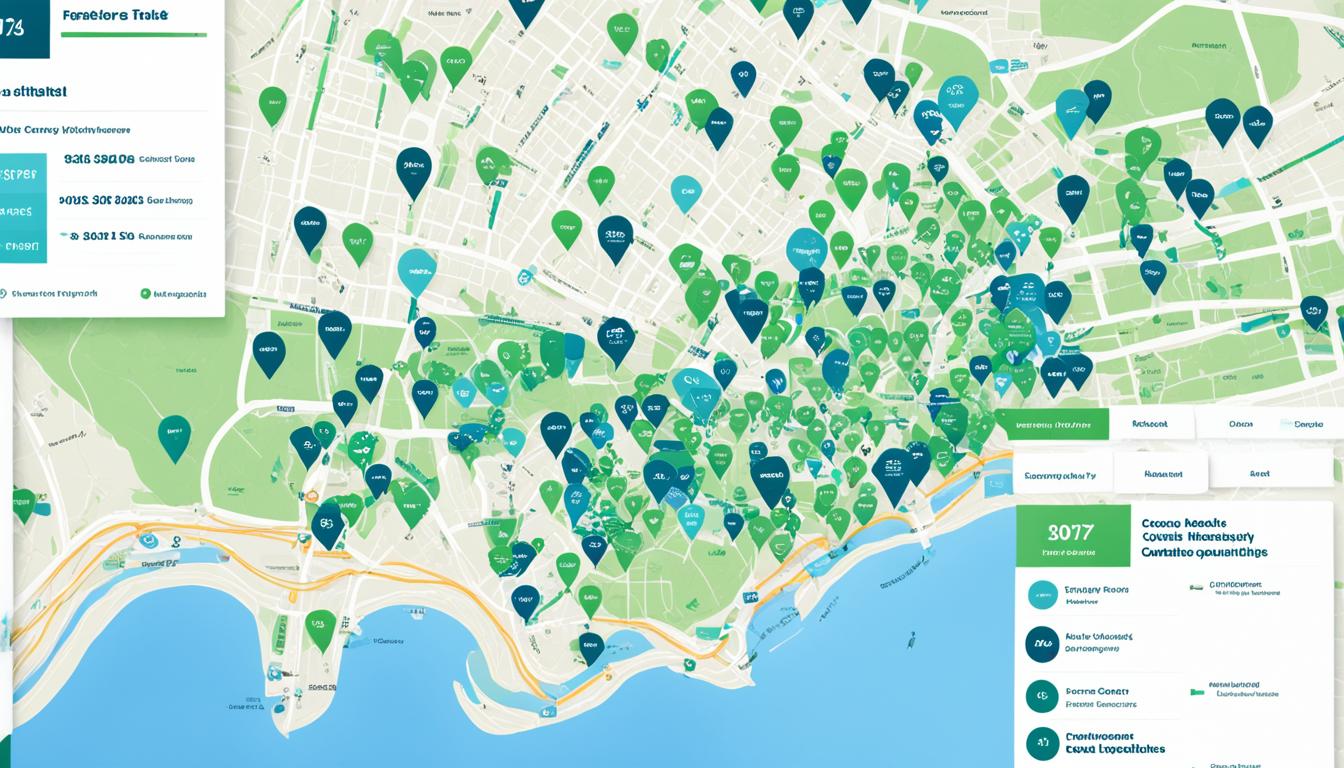Analyzing Market Conditions for Long-Term Rental is key to making money in long-term rentals. Learning about the housing market and the local economy helps you find areas that are often overlooked. It also lets you figure out where the market might go next. This way, choosing where to invest becomes a smart move, not a guessing game.
Getting advice from local experts and checking out real estate websites can teach you a lot. They share info on who’s renting, the local economy, and what the property scene looks like. Doing this kind of detailed analysis is a must for doing well in long-term rentals. It helps you keep up with changes in the market.
Key Takeaways
- Utilize local market insights to predict trends and maximize investment returns.
- Analyze housing market conditions and local economies for informed decision-making.
- Identify undervalued neighborhoods through thorough market research.
- Engage with local real estate professionals for deeper market understanding.
- Leverage online databases and community forums for tenant demographic data and property trends.
- Develop strategies based on comprehensive local analysis for long-term rental success.
Understanding the Importance of Analyzing Market Conditions for Long-Term Rental
Spending time on local market study helps you know unique market trends and property values. This is key for a smart investment plan. It lets you find chances and lower risks, making your decisions stronger.
Connecting with Local Professionals
Talking to local realtors and property managers is crucial. They know a lot about tenant trends, property worth, and how competitive the market is. Their local knowledge and first-hand experience can help you invest better.
Utilizing Online Tools and Resources
Today, online tools have changed the way we research markets. They provide instant information on the economy, who lives in the area, and trends. Using these tools can make local market analysis simpler. It helps you figure out property values and how competitive the market is. These tools show you the latest market situation, crucial for your planning.
Engaging in Community Forums
Joining community forums is also good for knowing the local market. They’re places where you can talk about the neighborhood, prices, and how competitive the market is. Talking with people from the area can provide unique insights. These might be insights that you won’t find in regular research. Forums can also tell you about new trends and how the economy affects the area.
Market Trends Shaping Long-Term Rental Opportunities
The long-term rental market changes a lot due to different trends. Knowing these trends well helps make smart choices.
Supply and Demand Factors
Supply and demand are big deals in the rental market. People’s numbers and job availability affect how much housing is needed. Building new homes affects how many homes are available.
Vacancy Rates and Housing Availability
To figure out if there’s enough housing, we look at vacancy rates. When lots of homes are empty, it might mean there’s too much housing. Few empty homes could mean the opposite. This all makes a big difference for investors.
Economic Indicators
Things like how many folks have jobs really shape the rental market. These measures show how the whole economy is doing. They have a big say in how much rent costs, if it’s a good time to invest, and if the market is stable.
| Factor | Description | Impact on Rentals |
|---|---|---|
| Population Growth | Increase in the number of residents in a given area. | Causes more need for rentals, maybe more rent money. |
| Employment Rates | Percentage of the labor force that is employed. | When more people work, they need more places to live. |
| Market Saturation | Condition where supply meets or exceeds demand. | Too many empty homes means rent prices might drop. |
Evaluating Long-Term Rental Market Conditions
Looking at the long-term rental market involves studying various things. This includes rental prices, how much the market is filled, and the local economy. By checking these, investors can see if their investments are worth it.
Analyzing Rental Prices and Market Saturation
It’s key to know rental prices to find good opportunities. High prices show a strong demand, while low ones mean there might be too many. Thinking about how much the market is filled shows if it’s a good place to invest. A full market might not grow much, but ones with less choice could earn more and keep tenants better.
Understanding Local Economic Conditions
Local economy plays a big part in the rental market’s health. Things like jobs, how much people earn, and who’s moving in can change the market a lot. When the economy is doing well, more jobs and people mean a higher need for rentals. But, if the economy slows down, so might the rental business.
A table is useful for quick checks on all these factors:
| Factor | Key Aspects | Impact on Rental Market |
|---|---|---|
| Rental Prices | Demand, Affordability | High prices may indicate strong demand; Low prices could show oversupply |
| Market Saturation | Supply vs. Demand Balance | Impacts rental yields and growth potential |
| Local Economic Conditions | Employment Rates, Median Income, Demographics | Positive conditions increase demand; Negative conditions reduce demand |
| Economic Indicators | Job Opportunities, Population Growth | Strong indicators boost rental market; Weak indicators might lower rental appeal |
| Housing Market Conditions | Availability, Pricing Trends | Influences overall rental market dynamics |
Strategies for Maximizing Long-Term Rental Investment Returns
Unlocking high long-term investment returns in real estate takes strategic steps. We will explore strategies to use undervalued properties, handle market fluctuations, and leverage real estate cycles.
Identifying Undervalued Properties
To get big returns over time, find properties that are undervalued. These might be in areas getting more popular or just need a little work. Thorough research and checking out the neighborhood can show you these opportunities.
Buying such properties for less than their worth can really boost your rental income.
Adapting to Market Fluctuations
Real estate markets can often change. Adapting to these changes is very important to protect and grow your investment. Lower or raise rent prices based on what the market can support.
Keeping your properties in good shape also helps. And always stay up to date on local market news. These steps can make the impact of market ups and downs smaller.
Tapping into Real Estate Cycles
Knowing about and using real estate cycles is key for investors. In prosperous times, property values rise. This is a good time to sell if it fits with your plans. But when prices drop, it’s a chance to buy properties for less.
By being smart about when you enter and leave the market, you can make the most out of your investments. This also helps your portfolio grow faster over time.
| Strategy | Benefit | Actionable Steps |
|---|---|---|
| Identifying Undervalued Properties | Ensures purchase below market value | – Conduct market research – Analyze neighborhood trends – Consult with local experts |
| Adapting to Market Fluctuations | Maintains income stability | – Adjust rental rates – Maintain property standards – Monitor market conditions |
| Tapping into Real Estate Cycles | Optimizes market timing | – Identify boom/bust phases – Time purchases and sales – Monitor economic trends |
Predicting Future Market Trends and Forecasts
To figure out future market forecasts, you must look at today’s economic conditions and population growth. By checking these parts, you’ll spot early signs of changes in housing market trends. Then, you can use this info to make smart investment choices.
Economic conditions are key in guessing real estate market changes. Things like inflation rates, jobs numbers, and GDP growth show where the housing market is headed. By watching these figures, you tune your investment plans to fit future market predictions.
Also, population growth really shapes the housing market. A bigger population means more need for homes, which could push up property prices. Watching how the population changes gives you a heads-up on new chances and how to handle risks.
An in-depth look into the real estate market gives you the chance to make well-thought-out decisions. By using both quality and quantity data, you can guess what the future market will be like. Then, you can change your strategies early. This keeps you in front in a fast-paced market.
| Factors | Indicators | Impact |
|---|---|---|
| Economic Conditions | Inflation, Employment Rates, GDP | Housing Demand, Pricing Structures |
| Population Growth | Demographic Changes, Migration Rates | Housing Availability, Property Values |
By keeping up with these forecasts, you can fit your strategies. This helps you keep your place and make the most of changes in the real estate market.
Conclusion
Achieving success in long-term rentals is all about understanding the local market deeply. This means knowing what’s happening and using this knowledge to make smart choices. It’s not just about reacting to what’s out there but planning for growth.
To do this, you need to look closely at who’s renting, the economy, and what properties are in demand. This gives you an edge and makes sure your choices are based on strong evidence. Talking to real estate pros, using online tools, and joining local talks help a lot. These efforts build a solid base for lasting success.
In short, making money and growing in the rental market is about combining deep research with sharp actions. Keeping an eye on trends and being ready for change is key. This strategy helps you withstand challenges and grab the chances that come your way.
Source Links
- https://newsroom.bankofamerica.com/content/newsroom/press-releases/2024/05/bofa-report–70–of-prospective-homebuyers-feel-renting-could-be.html
- https://www.linkedin.com/posts/portercameron_why-local-insights-are-your-secret-weapon-activity-7193391584174874624-KRFe
- https://www.linkedin.com/pulse/renting-versus-buying-home-which-right-you-now-dedicated-realtor-wcmdc?trk=public_post_main-feed-card_feed-article-content




